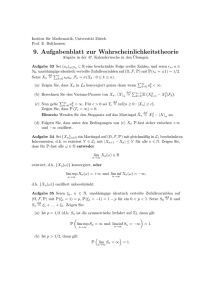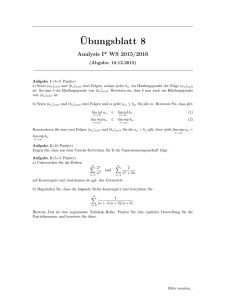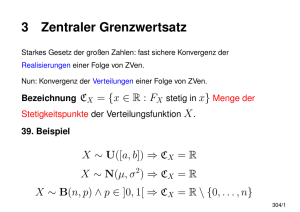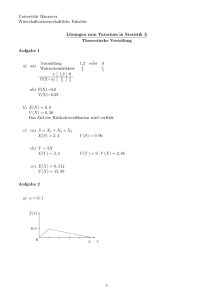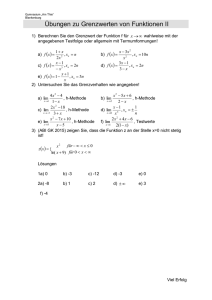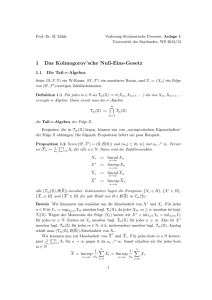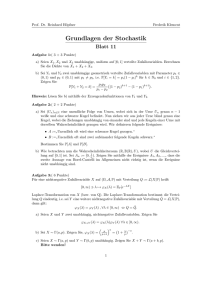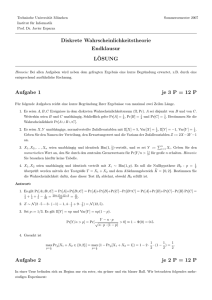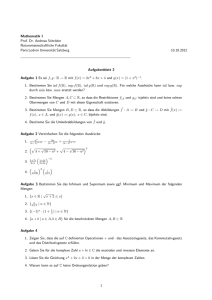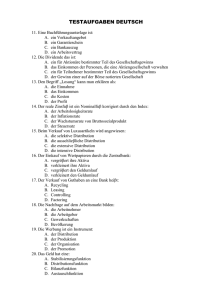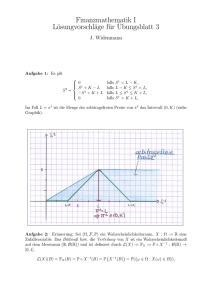1. Übungsblatt - Mathematics TU Graz
Werbung
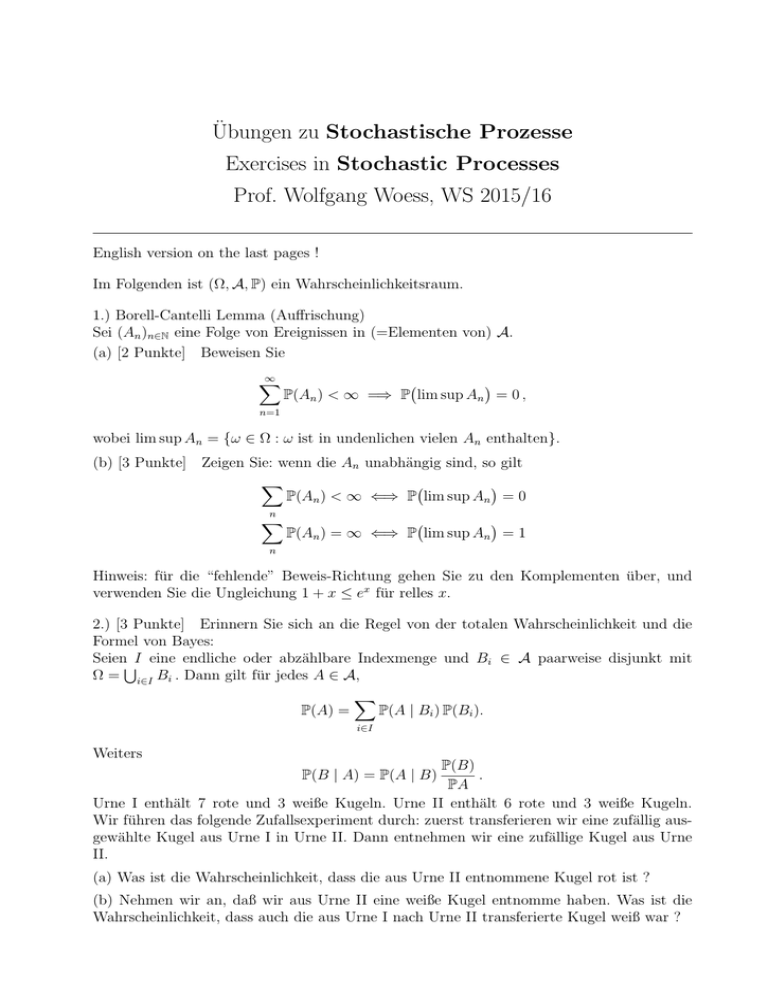
Übungen zu Stochastische Prozesse
Exercises in Stochastic Processes
Prof. Wolfgang Woess, WS 2015/16
English version on the last pages !
Im Folgenden ist (Ω, A, P) ein Wahrscheinlichkeitsraum.
1.) Borell-Cantelli Lemma (Auffrischung)
Sei (An )n∈N eine Folge von Ereignissen in (=Elementen von) A.
(a) [2 Punkte] Beweisen Sie
∞
∑
(
)
P(An ) < ∞ =⇒ P lim sup An = 0 ,
n=1
wobei lim sup An = {ω ∈ Ω : ω ist in undenlichen vielen An enthalten}.
(b) [3 Punkte] Zeigen Sie: wenn die An unabhängig sind, so gilt
∑
(
)
P(An ) < ∞ ⇐⇒ P lim sup An = 0
n
∑
(
)
P(An ) = ∞ ⇐⇒ P lim sup An = 1
n
Hinweis: für die “fehlende” Beweis-Richtung gehen Sie zu den Komplementen über, und
verwenden Sie die Ungleichung 1 + x ≤ ex für relles x.
2.) [3 Punkte] Erinnern Sie sich an die Regel von der totalen Wahrscheinlichkeit und die
Formel von Bayes:
Seien∪I eine endliche oder abzählbare Indexmenge und Bi ∈ A paarweise disjunkt mit
Ω = i∈I Bi . Dann gilt für jedes A ∈ A,
P(A) =
∑
P(A | Bi ) P(Bi ).
i∈I
Weiters
P(B)
.
PA
Urne I enthält 7 rote und 3 weiße Kugeln. Urne II enthält 6 rote und 3 weiße Kugeln.
Wir führen das folgende Zufallsexperiment durch: zuerst transferieren wir eine zufällig ausgewählte Kugel aus Urne I in Urne II. Dann entnehmen wir eine zufällige Kugel aus Urne
II.
P(B | A) = P(A | B)
(a) Was ist die Wahrscheinlichkeit, dass die aus Urne II entnommene Kugel rot ist ?
(b) Nehmen wir an, daß wir aus Urne II eine weiße Kugel entnomme haben. Was ist die
Wahrscheinlichkeit, dass auch die aus Urne I nach Urne II transferierte Kugel weiß war ?
3.) [3 Punkte] Betrachten Sie das Beispiel der Irrfahrt des Betrunkenen mit Zustandsraum
{0, 1, . . . , N } und Übergangswahrscheinlichkeiten
p(0, 0) = p(N, N ) = 1 ,
p(k, k + 1) = p , p(k, k − 1) = 1 − p(=: q) für k ∈ {1, . . . , N − 1} .
Bestimmen Sie für k = 0, . . . , N die Wahrscheinlichkeit
F (k, 0) = P[Absorption in 0 | Start in k ]
Hinweis: erstellen Sie eine lineare Rekursion für F (k, 0) und lösen Sie diese. [Falls Ihnen die
Methode zur Lösung linearer Rekursionen mit konstanten Koeffizienten nicht bekannt ist,
kontaktieren Sie KollegInnen oder W. Woess.]
4.) [2 Punkte] Sei X eine nicht-negative Zufallsvariable. Zeigen Sie: wenn X ganzzahlige
Werte hat, so ist der Erwartungswert
E(X) =
∞
∑
P[X ≥ n] ,
n=1
und wenn X beliebig rellewertig ist, so ist
E(X) < ∞ ⇐⇒
∞
∑
P[X ≥ n] < ∞.
n=1
5.) [3 Punkte] Exponential- und Gammaverteilung (Auffrischung). Erinnerung: sind X und
Y zwei unabhängige reelle Zufallsvariable mit Dichtefunktionen (bezüglich dem LebesgueMaß) fX und fY , so ist die Dichtefunktion von X + Y gegeben durch die Faltung
∫
fX+Y (z) =
fX (x)fY (z − x) dz .
R
Die Gammaverteilung γ(λ, r) mit Parametern r, λ > 0 hat die Dichtefunktion
f (x) =
λr r−1 −λx
x e
1(0 , ∞) (x)
Γ(r)
Für r = 1 ist dies die Exponentialverteilung mit Parameter λ.
Seien X und Y unabhängig und bezüglich γ(λ, r), bzw. γ(λ, s) verteilt. Bestimmen Sie die
Verteilung von X + Y .
6.) [3 Punkte] Sei (σn )n∈N eine Folge unabhängiger, identisch verteilter Zufallsvariablen mit
Exponentialverteilung(λ). Sei τ0 = 0 und τn = σ1 +· · ·+σn (n ≥ 1). Aus dem vorangehenden
Beispiel kennen Sie die Verteilung von τn . Nun betrachten Sie den Zufallsprozess (Xt )t≥0 in
stetiger Zeit mit
Xt = n ⇐⇒ τn ≤ t < τn+1 , n ∈ No .
Bestimmen Sie die Verteilung von Xt .
ENGLISH VERSION
In the sequel, (Ω, A, P) is a probability space.
1.) Borell-Cantelli Lemma (reminder)
Let (An )n∈N be a sequence of events in (= elements of) A.
(a) [2 points] Prove that
∞
∑
(
)
P(An ) < ∞ =⇒ P lim sup An = 0 ,
n=1
where lim sup An = {ω ∈ Ω : ω belongs to infinitely many An }.
(b) [3 points Prove that if the An are independent, then
∑
(
)
P(An ) < ∞ ⇐⇒ P lim sup An = 0
n
∑
(
)
P(An ) = ∞ ⇐⇒ P lim sup An = 1
n
Hint: for the “missing” part of the proof, pass to coplements and use the inequality 1+x ≤ ex
for real x.
2.) [3 Punkte] Recall the rule of total probablity and the formula of Bayes:
∪
Let I be a finite or countable indes set and Bi ∈ A pairwise disjoint mwith Ω = i∈I Bi .
Then for every A ∈ A,
∑
P(A) =
P(A | Bi ) P(Bi ).
i∈I
Furthermore,
P(B)
.
PA
Urn I contains 7 red and 3 white balls. Urn II contains 6 red und 3 white balls. Wir perform
the following random experiment: Zufallsexperiment durch: first, a randomly chose ball is
transferred from Urn I into Urn II. Then we extract a random ball from Urn II.
P(B | A) = P(A | B)
(a) What is the probability that the ball extracted from Urn II is red ?
(b) Suppose that the ball extracted from Urn II is white. What is the probability that also
the ball transferred from Urn I to Urn II was white ?
3.) [3 points] Consider the example of the drunkard’s walkwith state space {0, 1, . . . , N }
and transition probabilities
p(0, 0) = p(N, N ) = 1 ,
p(k, k + 1) = p , p(k, k − 1) = 1 − p(=: q) for k ∈ {1, . . . , N − 1} .
Compute for k = 0, . . . , N the probability
F (k, 0) = P[absorption in 0 | start in k ]
Hint: set up a linear recursion for F (k, 0) and solve it. [If you are not familiar with the
mothod for solving linear recursions with constant coefficients, contact your colleagues or
W. Woess.]
4.) [2 points] Let X be a non-negative random variable. Prove the fololowing: if X is
integer-valued, then the expectation is
E(X) =
∞
∑
P[X ≥ n] ,
n=1
and if X is arbitrary real, then
E(X) < ∞ ⇐⇒
∞
∑
P[X ≥ n] < ∞.
n=1
5.) [3 points] Exponential- and gamma distribution (reminder). Recall: if X and Y are independent real random variables with densitiy functions (with respect to Lebesgue measure)
fX and fY , then the denstiy function of X + Y is given by the convolution
∫
fX+Y (z) =
fX (x)fY (z − x) dz .
R
The Gamma distribution γ(λ, r) with parameters r, λ > 0 has the densitiy function
f (x) =
λr r−1 −λx
x e
1(0 , ∞) (x)
Γ(r)
for r = 1, this is the exponential distribution with parameter λ.
Let X and Y be independent and distributed according to γ(λ, r), resp. γ(λ, s). Determine
the distribution of X + Y .
6.) [3 points] Let (σn )n∈N be a sequence of i.i.d. random variables with exponential distribution(λ).
Let τ0 = 0 and τn = σ1 + · · · + σn (n ≥ 1). From the preceding exercise, you know the distribution of τn . Now consider the random process (Xt )t≥0 in continuous time given by
Xt = n ⇐⇒ τn ≤ t < τn+1 ,
Determine the distribution of Xt .
n ∈ No .
